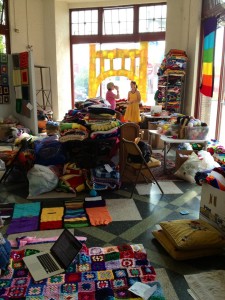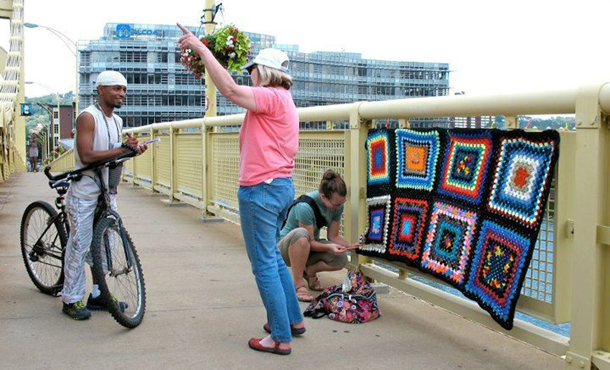On the weekend of August 10, Pittsburgh’s famous Andy Warhol Bridge will begin wearing a massive knitted sweater of sorts, designed, created and installed (save for high-altitude stuff left to professionals) by more than 1,400 volunteer knitters in and around Pittsburgh.
Once complete, Knit the Bridge, led by Amanda Gross ’07, MA ’13 (conflict transformation), will represent the largest-ever U.S. “yarnbomb,” which Gross describes as a sort of “joyful graffiti” that covers public spaces and objects in knitted artwork. The installation, which will stay up for a month, will include thousands of colorful 34 x 72-inch panels covering the bridge’s superstructure, plus miles of yarn knitted into narrower railing covers.
Gross focused on art as a peacebuilding tool while studying at EMU’s Center for Justice and Peacebuilding and came up with the idea of the yarnbomb as a way to inspire wide community participation in a public art project. For the past year, she has been working full-time on the project, which is funded through an Indiegogo campaign and support from numerous organizations.
Process as important as product
“I was looking for different ways to connect people and connect different communities,” says Gross, who organized a much smaller yarnbomb in downtown Pittsburgh a few years ago with other members of the city’s Fiberarts Guild. “The process is just as important as the final product.”

While covering a major and massive physical feature in Pittsburgh with yarn will be a significant artistic achievement in and of itself, both the act of knitting and bridges are symbolic of the connectedness Gross hopes to achieve through Knit the Bridge.
Now entering the final month of frenzied preparations, the community-connecting objective has already been a considerable success. As of early July 2013, some 1,500 people had contributed knitted panels, representing more than 80 percent of municipalities and townships within Allegheny County (home to Pittsburgh), as well as numerous other communities within southwest Pennsylvania.
“It’s really a community project. It’s a wonderful thing, and it’s a privilege to be working on it,” says Penny Mateer, an artist and lifelong Pittsburgh resident who is co-directing Knit the Bridge.
“Amanda is amazing,” continues Mateer. “The initial concept itself was a really lovely design [and] she has quite a vision. She engages people in a way that has been extraordinary.”
All ages, races, ethnicities, classes joining in
Ranging in age from very young to very old, knitters who have contributed panels represent the city’s different racial, ethnic and class communities. Elementary schools have participated; kids in juvenile detention have knitted panels; retirement homes have pitched in. The National Public Radio affiliate in Pittsburgh ran a story in late June about a group of boys in a local program for at-risk teens who are finger-knitting a piece for the bridge.
Gross and her colleagues drummed up support for the effort through social media, word of mouth, and with the help of about 90 people who volunteered to lead outreach and organize knitting parties in their own communities. Other than rules against letters, numbers or other representational imagery, contributors were given free rein to design their individual panels.
The Knit the Bridge installation will remain up through September 8. After coming down, the panels will be washed and donated to charity.
“[Knit the Bridge] connects everybody,” says Sherri Roberts, vice-president of the Fiberarts Guild of Pittsburgh, one of the project’s major supporters. “From start to finish, it has unified, it has made joyful, and it has connected.”
Like Gross, she hopes that new connections made through participation in Knit the Bridge will continue long after the panels come down.
One reason for the project’s wide appeal, Gross says, is that knitting and crocheting are generally seen as accessible “crafts” rather than fine art.
“That part has made it really easy for people to get excited about it and feel like they can be a part of it,” Gross says. “A lot of people are missing that…. They just want an opportunity to participate.”
Hundreds of volunteers doing the logistics
In addition to the knitters, hundreds of other volunteers – a pro-bono attorney, technical advisors, database developers – have pitched in on the formidable logistics of pulling off the yarn bomb, Mateer notes.
Gross said that behind-the-scenes work has been the biggest challenge of the project, particularly the task of shepherding an unusual and never-before-attempted idea through the bureaucracy of local government. (It’s not every day that someone rings the Allegheny County administrative offices asking how to go about covering a major downtown bridge in yarn.) In mid-June, the county council unanimously approved an ordinance to allow Knit the Bridge to proceed.
“I’m really hopeful that the county will figure out some sort of public art policy, and that this will open more doors for more creative, grassroots projects,” Gross said.
Also as of late June, the community-made panels totaled 116,688 square feet of hand-knitted or –crocheted panels. The black border to go around the knitted panels will use 600 miles of yarn, while the bits on the towers – to be installed by a rigging company – will be close to 3,000 linear feet of machine-knitted yarn.
“Participating has meant a lot to people,” Gross adds. “People really jumped at the opportunity to do something positive for their community.”
